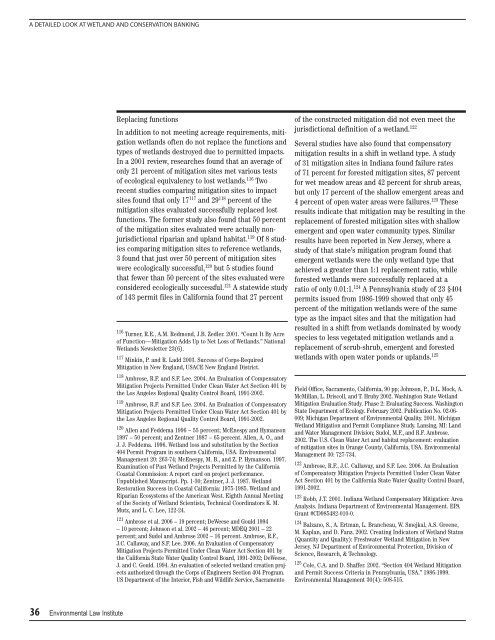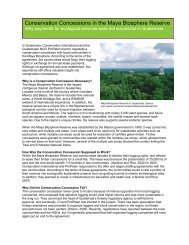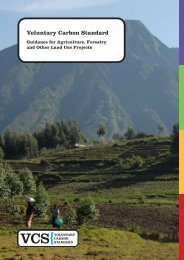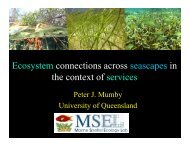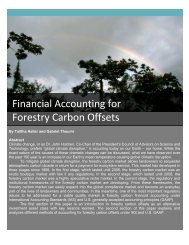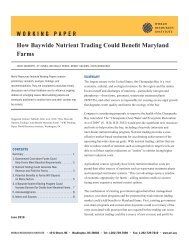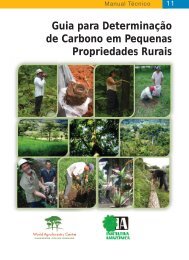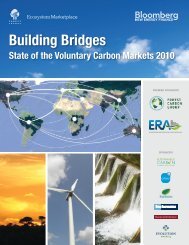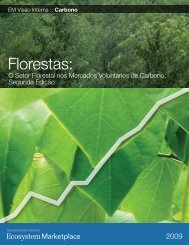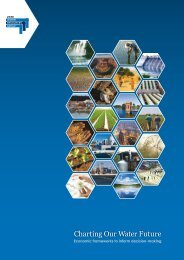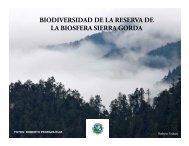Design of US Habitat Banking Systems to Support the Conservation ...
Design of US Habitat Banking Systems to Support the Conservation ...
Design of US Habitat Banking Systems to Support the Conservation ...
You also want an ePaper? Increase the reach of your titles
YUMPU automatically turns print PDFs into web optimized ePapers that Google loves.
A DETAILED LOOK AT WETLAND AND CONSERVATION BANKINGReplacing functionsIn addition <strong>to</strong> not meeting acreage requirements, mitigationwetlands <strong>of</strong>ten do not replace <strong>the</strong> functions andtypes <strong>of</strong> wetlands destroyed due <strong>to</strong> permitted impacts.In a 2001 review, researches found that an average <strong>of</strong>only 21 percent <strong>of</strong> mitigation sites met various tests<strong>of</strong> ecological equivalency <strong>to</strong> lost wetlands. 116 Tworecent studies comparing mitigation sites <strong>to</strong> impactsites found that only 17 117 and 29 118 percent <strong>of</strong> <strong>the</strong>mitigation sites evaluated successfully replaced lostfunctions. The former study also found that 50 percent<strong>of</strong> <strong>the</strong> mitigation sites evaluated were actually nonjurisdictionalriparian and upland habitat. 119 Of 8 studiescomparing mitigation sites <strong>to</strong> reference wetlands,3 found that just over 50 percent <strong>of</strong> mitigation siteswere ecologically successful, 120 but 5 studies foundthat fewer than 50 percent <strong>of</strong> <strong>the</strong> sites evaluated wereconsidered ecologically successful. 121 A statewide study<strong>of</strong> 143 permit files in California found that 27 percent116 Turner, R.E., A.M. Redmond, J.B. Zedler. 2001. “Count It By Acre<strong>of</strong> Function—Mitigation Adds Up <strong>to</strong> Net Loss <strong>of</strong> Wetlands.” NationalWetlands Newsletter 23(6).117 Minkin, P. and R. Ladd 2003. Success <strong>of</strong> Corps-RequiredMitigation in New England, <strong>US</strong>ACE New England District.118 Ambrose, R.F. and S.F. Lee. 2004. An Evaluation <strong>of</strong> Compensa<strong>to</strong>ryMitigation Projects Permitted Under Clean Water Act Section 401 by<strong>the</strong> Los Angeles Regional Quality Control Board, 1991-2002.119 Ambrose, R.F. and S.F. Lee. 2004. An Evaluation <strong>of</strong> Compensa<strong>to</strong>ryMitigation Projects Permitted Under Clean Water Act Section 401 by<strong>the</strong> Los Angeles Regional Quality Control Board, 1991-2002.120 Allen and Feddema 1996 – 55 percent; McEnespy and Hymanson1997 – 50 percent; and Zentner 1987 – 65 percent. Allen, A. O., andJ. J. Feddema. 1996. Wetland loss and substitution by <strong>the</strong> Section404 Permit Program in sou<strong>the</strong>rn California, <strong>US</strong>A. EnvironmentalManagement 20: 263-74; McEnespy, M. B., and Z. P. Hymanson. 1997.Examination <strong>of</strong> Past Wetland Projects Permitted by <strong>the</strong> CaliforniaCoastal Commission: A report card on project performance.Unpublished Manuscript. Pp. 1-30; Zentner, J. J. 1987. WetlandRes<strong>to</strong>ration Success in Coastal California: 1975-1985. Wetland andRiparian Ecosystems <strong>of</strong> <strong>the</strong> American West. Eighth Annual Meeting<strong>of</strong> <strong>the</strong> Society <strong>of</strong> Wetland Scientists, Technical Coordina<strong>to</strong>rs K. M.Mutz, and L. C. Lee, 122-24.121 Ambrose et al. 2006 – 19 percent; DeWeese and Gould 1994– 10 percent; Johnson et al. 2002 – 46 percent; MDEQ 2001 – 22percent; and Sudol and Ambrose 2002 – 16 percent. Ambrose, R.F.,J.C. Callaway, and S.F. Lee. 2006. An Evaluation <strong>of</strong> Compensa<strong>to</strong>ryMitigation Projects Permitted Under Clean Water Act Section 401 by<strong>the</strong> California State Water Quality Control Board, 1991-2002; DeWeese,J. and C. Gould. 1994. An evaluation <strong>of</strong> selected wetland creation projectsauthorized through <strong>the</strong> Corps <strong>of</strong> Engineers Section 404 Program.<strong>US</strong> Department <strong>of</strong> <strong>the</strong> Interior, Fish and Wildlife Service, Sacramen<strong>to</strong><strong>of</strong> <strong>the</strong> constructed mitigation did not even meet <strong>the</strong>jurisdictional definition <strong>of</strong> a wetland. 122Several studies have also found that compensa<strong>to</strong>rymitigation results in a shift in wetland type. A study<strong>of</strong> 31 mitigation sites in Indiana found failure rates<strong>of</strong> 71 percent for forested mitigation sites, 87 percentfor wet meadow areas and 42 percent for shrub areas,but only 17 percent <strong>of</strong> <strong>the</strong> shallow emergent areas and4 percent <strong>of</strong> open water areas were failures. 123 Theseresults indicate that mitigation may be resulting in <strong>the</strong>replacement <strong>of</strong> forested mitigation sites with shallowemergent and open water community types. Similarresults have been reported in New Jersey, where astudy <strong>of</strong> that state’s mitigation program found thatemergent wetlands were <strong>the</strong> only wetland type thatachieved a greater than 1:1 replacement ratio, whileforested wetlands were successfully replaced at aratio <strong>of</strong> only 0.01:1. 124 A Pennsylvania study <strong>of</strong> 23 §404permits issued from 1986-1999 showed that only 45percent <strong>of</strong> <strong>the</strong> mitigation wetlands were <strong>of</strong> <strong>the</strong> sametype as <strong>the</strong> impact sites and that <strong>the</strong> mitigation hadresulted in a shift from wetlands dominated by woodyspecies <strong>to</strong> less vegetated mitigation wetlands and areplacement <strong>of</strong> scrub-shrub, emergent and forestedwetlands with open water ponds or uplands. 125Field Office, Sacramen<strong>to</strong>, California, 90 pp; Johnson, P., D.L. Mock, A.McMillan, L. Driscoll, and T. Hruby 2002. Washing<strong>to</strong>n State WetlandMitigation Evaluation Study. Phase 2: Evaluating Success. Washing<strong>to</strong>nState Department <strong>of</strong> Ecology. February 2002. Publication No. 02-06-009; Michigan Department <strong>of</strong> Environmental Quality. 2001. MichiganWetland Mitigation and Permit Compliance Study. Lansing, MI: Landand Water Management Division; Sudol, M.F., and R.F. Ambrose.2002. The U.S. Clean Water Act and habitat replacement: evaluation<strong>of</strong> mitigation sites in Orange County, California, <strong>US</strong>A. EnvironmentalManagement 30: 727-734.122 Ambrose, R.F., J.C. Callaway, and S.F. Lee. 2006. An Evaluation<strong>of</strong> Compensa<strong>to</strong>ry Mitigation Projects Permitted Under Clean WaterAct Section 401 by <strong>the</strong> California State Water Quality Control Board,1991-2002.123 Robb, J.T. 2001. Indiana Wetland Compensa<strong>to</strong>ry Mitigation: AreaAnalysis. Indiana Department <strong>of</strong> Environmental Management. EPAGrant #CD985482-010-0.124 Balzano, S., A. Ertman, L. Brancheau, W. Smejkal, A.S. Greene,M. Kaplan, and D. Fanz. 2002. Creating Indica<strong>to</strong>rs <strong>of</strong> Wetland Status(Quantity and Quality): Freshwater Wetland Mitigation in NewJersey. NJ Department <strong>of</strong> Environmental Protection, Division <strong>of</strong>Science, Research, & Technology.125 Cole, C.A. and D. Shaffer. 2002. “Section 404 Wetland Mitigationand Permit Success Criteria in Pennsylvania, <strong>US</strong>A.” 1986-1999.Environmental Management 30(4): 508-515.36 Environmental Law Institute


